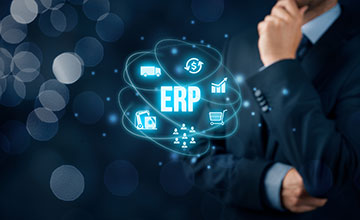Perhaps you already have an ERP but are wondering if an MRP would be better at solving some of your inventory and manufacturing process problems? Or perhaps you are considering whether to purchase an MRP or ERP, but need to understand the differences? This article walks through some of the key differences between an MRP and an ERP and helps you determine the right approach for your organisation.
ERP and MRP are computer-based systems used by organisations to manage their business operations. An MRP is specific to inventory and manufacturing while ERP is enterprise-wide, and performs a very broad range of functions.
What is MRP?
MRP stands for Material Requirements Planning.
MRP is a computer-based system used by organisations for planning and managing manufacturing and inventory. The diagram below shows the typical workflow of an MRP system. MRP is a “push” based planning system that starts with the desired level of production and then works out the inputs required.
MRP was developed in the 1960s with the growth of business-based computing systems. It was developed from computerized inventory control systems, which were first developed in the 1940s and 1950s.
In the 1980s, MRPs expanded to cover functions within an organization that supported the manufacturing process e.g. accounting and HR. These expanded systems were called MRP II.
With MRP II, the focus of MRP switched from forecasting and planning to the optimization of the manufacturing process or inventory management.
In the 1980s and 1990s, the MRP system was challenged by new methods of production and inventory management such as JIT and FMS. Today, MRP is often used alongside these other production management methods with an emphasis on managing inputs to production. Such MRP systems are sometimes called Demand-Driven MRP (DDMRP).
What is ERP?
ERP stands for Enterprise Resource Planning.
ERPs are a computer system used by organisations to manage data flows and information processes across departments. It is a single application with a central database for the whole organization.
The goal of an ERP is to make an organisation’s workflows more efficient. It does this by sharing information throughout an organization, the codification of workflows, and the tracking of performance.
ERPs developed from MRPs in the 1980s. It expanded beyond the functionality of MRPs to cover the management of data flows and processes throughout an organization. Today it comprises a core system with modules and integrations that allows it to touch every functional area within an organization, including production.
What are the main differences? MRP vs ERP
Scope
This is the key difference. ERP is an enterprise-wide solution, while MRP is a specialized system for the manufacturing and inventory business units. MRP may touch some related functional areas such as accounting but it is not an enterprise-wide solution.
Flexibility
ERP is a flexible solution that can be expanded in scope with modules and integrations. It can start small and grow with your organization. For example, maybe you buy an ERM to help you improve workflows between departments but then later on use it for CRM. In contrast, the scope of MRP is relatively fixed.
Cost
ERPs tend to be more expensive because they cover a whole enterprise and have more functionality.
Users
By design, an ERP will accommodate a range of users across an enterprise with differing degrees of expertise. To enable this, ERP interfaces tend to be intuitive and customizable. In contrast, an MRP will have a small number of specialized users who may require training to use the system.
Does my business need a separate MRP system?
These are three questions you should consider when you are making a decision on buying an MRP:
- Do you own an ERP or do you plan to buy an ERP soon? If so then you may not need an MRP. Many ERPs have some MRP functionality built-in. This may be sufficient for your needs and it is free for you to try. Your ERP may also support a separate MRP module. This may be cheaper than buying a separate MRP system. In either case, it may be worth trying out this MRP functionality first before buying a dedicated and more expensive MRP system.
- Will an MRP provide you with any advantages over an ERP with your manufacturing or inventory? MRPs are niche systems so unless your enterprise will benefit specifically from something that an MRP has which an ERP doesn’t then stick with the more versatile ERP.
- Do you have the IT personnel to support the more complicated MRP?
Conclusion
MRPs are a niche solution that will benefit a small sub-set of organisations in manufacturing and inventory-heavy industries. If you need a dedicated MRP, the benefits will be obvious to you. When a farmer looks at a tractor and a car, he knows the tractor will be more useful in the field.
ERPs are more useful overall and in many cases will provide most organisations with all the MRP functionality they will ever need. If you are not sure whether you need an MRP or EPR, chances are an ERP will do the job just fine.




